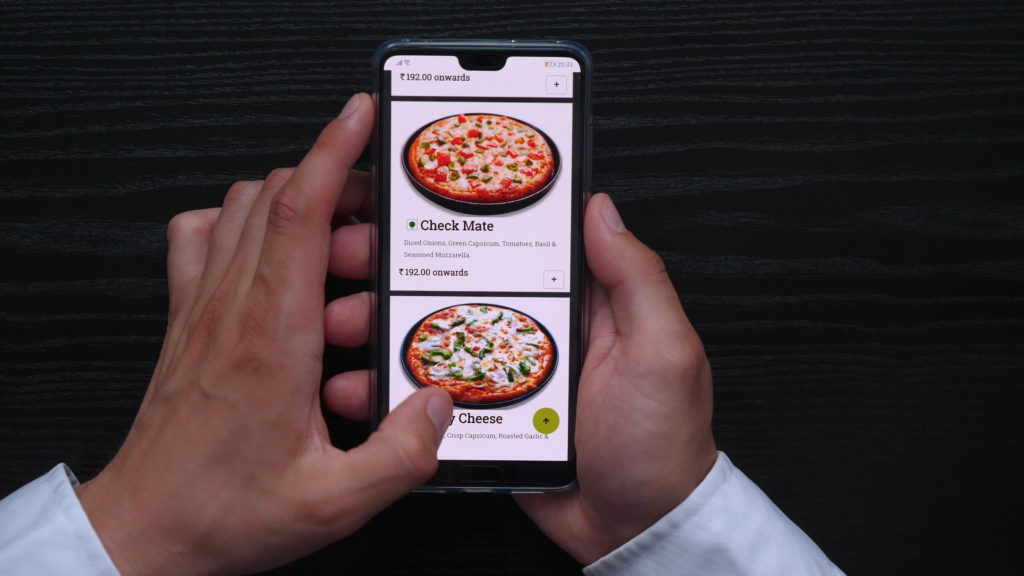
- Products
- Solutions
- Learn
- Partner
- Try Now
Launching a pizza delivery business is not just a popular option for food delivery, but it can also be profitable due to the high-profit margin. If you prefer making one-of-a-kind dishes and enjoy cooking, starting a pizza business might be a rewarding endeavor.
It’s no wonder that pizza shops are among the most popular types of restaurants, with 93 percent of Americans eating it at least once a month.
Do you own a pizzeria or looking to start one? Is it becoming more difficult to handle orders, customers, and workers at the same time? Don’t you think it would be more convenient for your customers to have their favorite pizzas delivered to their door? Have you ever considered creating an on-demand pizza delivery app? Continue reading this article to gain an in-depth understanding of the on-demand pizza delivery solution.

How to start a pizza business?
- Select a pizza shop style
Pizza ideas range from neighborhood house-of-pizza takeout eateries to high-end full-service businesses with imported wood-burning ovens. At this stage, determining where you stand on the spectrum and the restaurant alternatives you’ll provide is critical.
- Full-Service Pizzeria – Pizza, especially when combined with a bar, lends itself nicely to dining in. It’s communal food that works well for large parties, events, and celebrations. Whether you go full service, think about whether you’ll have TVs to appeal to the sports crowd or if you’ll provide a more upscale experience.
- Takeaway Pizzeria – Pizza is a traditional takeout item. It’s reasonably priced, customizable, and travels well. Even if your pizza is full service, offering takeaway is a fantastic idea. Customers are used to it.
- Pizza Delivery – If you want to offer delivery, evaluate whether you will use in-house drivers or outsource to a third party.
- Food Truck Pizzeria– Mobile pizzerias have exploded in popularity in recent years, and with good reason: they’re an excellent match for commercial areas, college towns, and special events such as weddings and festivals. Consider the particular licenses and permits that will be required if you go this way.
- A Ghost Kitchen – Ghost kitchens, cloud kitchens, or dark kitchens, a concept that rose in popularity during the epidemic, provide meals only for internet ordering and delivery. There is no storefront for people to visit, and there are no related expenditures to running one.
- Develop a comprehensive business plan:
The first stage, like with any restaurant, is to create a business plan. This is the strategy that will take you from a wild notion to opening day. Creating a business model will not only help you become organized, but will also act as your primary tool for presenting your idea to partners, investors, and other stakeholders who will be required to get your concept off the ground.
Outline your ideas, vision, difficulties, and potential traps in detail. A table of contents, a description of your pizza business, management and financial plan, marketing plan, operating procedures, business description, competition, balance sheet, capital, equipment, supply sheet, business insurance, break-even analysis, cash flow, income projections, month-by-month detail for year one, and a three-year summary should all be included in your plan.
- Develop a pizza menu, decide what to sell
For any pizza business, you’ll need to consider the kind of pizzas and other things you intend to sell. Once you’ve opened for business, it’s important to be adaptable; if consumers are asking for something you don’t have, you should definitely add it to your menu as soon as feasible.
You’ll want to make sure you have a decent selection of different types and sizes of pizza, as well as popular toppings and combinations.
The first item to think about is the pizza bases: will you create them from scratch or buy them ready-made? Will you provide a variety of bases, such as thin, thick, deep-pan, and packed crust?
Consider various sorts of pizza products you may sell, such as folded calzones and stuffed crusts, along with other food items and soft drinks.

- Pizza delivery service
Now, the important thing to remember is that there should be no compromise on the pizza delivery service. Because pizza is accessible from a variety of sources, it is critical to the success of your business that your delivery service is great. As a first stage, choose the radius within which you will transport – for example, three or four miles – and how you will most efficiently utilize the drivers of your trucks. The more orders that are delivered on each delivery, the lower your per-pizza delivery cost.
Your customers will expect an easy-to-use ordering system – by phone, mobile app, and/or online – and to be able to count on their pizzas arriving relatively quickly after they make their order. Consider how long your pizza delivery times will be, keeping in mind that you will have to prepare and cook the pizza, box it, and then deliver it.
- Setup pricing
How will you set your prices?
It is critical to get the price correct. It is critical to ensure that the difference between the cost of the pizza and other food item materials and the selling price is sufficient to pay all of your running expenses, including delivery charges and your personal profits.
However, the catering industry is highly competitive, and it would be prudent to price in line with your direct rivals unless you are targeting a specialized market that your competitors do not serve. For example, if you want to open in a wealthy neighborhood, you can opt to offer a more upscale selection of pizzas and other side dishes.
You may emphasize that you create all of your dough from scratch, use only the best Italian cheeses, hams, salamis, and so on, and bake your pizzas in real wood-fired pizza ovens. Your items would be far more costly than those geared at the general public.

- Branding, marketing, and promotion strategy
With effective marketing, you can set up your grand opening for success and bring customers in the door. The best place to begin is by developing your restaurant marketing strategy, in which you may establish goals, decide which best practices and recommendations to follow, and arrange your marketing calendar and budget for that crucial first year.
Creating a marketing plan begins with establishing exactly what you are marketing. What makes your pizzeria stand out? What do your surroundings or aesthetic have to offer customers? Your branding will be driven by your pizzeria’s unique product and its intended demographic.
When deciding on your marketing and advertising strategy for your pizza business, consider the following:
- Who are your ideal pizzeria customers?
- What platforms are you planning to employ for internet marketing?
- Will you rely on organic marketing or pay for advertising?
- Will you use influencer marketing as part of your strategy?
- Where does your target demographic spend their time? What are your options for advertising in these areas?
Jungleworks suite: Everything at one place for your pizza delivery business
With Jungleworks suite, get the best-in-class ordering platform (Yelo), delivery management software (Tookan), and growth platform (Hippo). From a seamless ordering experience for your customer on your pizzeria app to on-time doorstep deliveries, you can manage everything from one place.
To ensure your online business’s success – and to increase loyalty, use, engagement, and customer referrals – you must prioritize customer interaction and establish and implement an effective communication and engagement plan. That being said, Hippo, serves to be the right fit for your pizza business as it allows you to engage with your customers. Chatbots, live chats, emails, SMS, Whatsapp blasts, push notifications can help you retain and retarget your customers.
If you’re looking for a complete on-demand pizza delivery solution, book a demo with our business experts today.
Subscribe to stay ahead with the latest updates and entrepreneurial insights!

Subscribe to our newsletter
Get access to the latest industry & product insights.





















